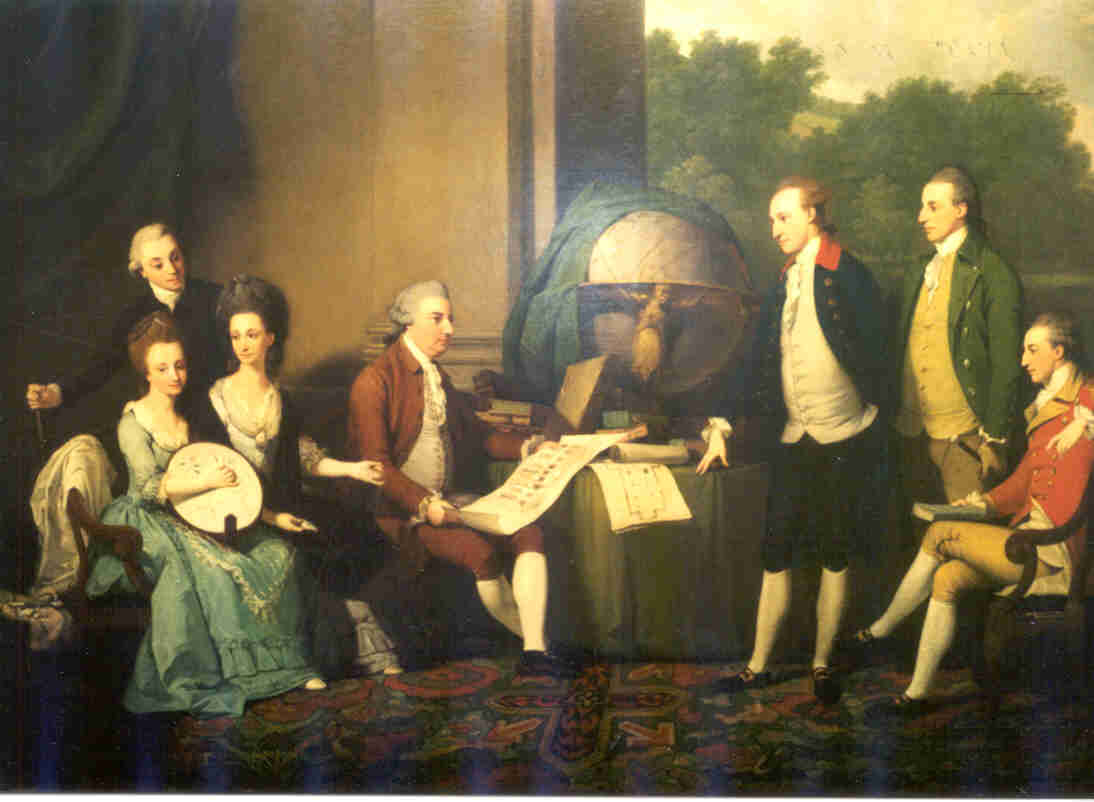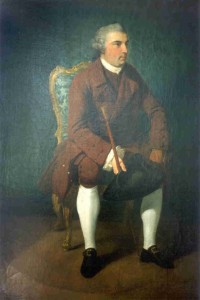Read an article about the smallpox vaccination in 1836 of a member of the Drake family. It was written by Barney Tyrwhitt Drake and first appeared in Genealogists’ Magazine, March 2014 (journal of the Society of Genealogists – www.sog.org.uk).
The Drake family – a dynasty of Lords of the Manor of Amersham
This article is based on a panel produced for the Museum by Gerry Selby
In 1603, Joan Tothill married Francis Drake (c.1580–1634), son of Richard Drake of Devon (1535-1603) and a godson of Sir Francis Drake. He was probably born in Esher in 1580, but no parish records survive. She was the daughter of William Tothill who already owned the Manor of Weedon Hill, and the neighbouring houses and properties of Woodrow and Shardeloes. In 1624 William Tothill moved to Shardeloes and started negotiations to buy the Manor of Amersham and its right to elect two Members of Parliament. Francis Drake became MP for Amersham in 1625.
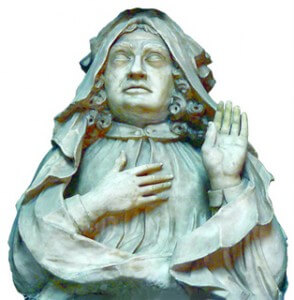
Sir William Drake Bt. (1606-69), grandson of William Tothill, inherited the Amersham estates in 1626, and he finally completed the purchase of the Borough of Amersham from the Earl of Bedford in 1637 for £7,500. This included Bury Farm and common rights on Amersham Common and Wycombe Heath, which enabled him to enclose large quantities of land. He became a baronet in 1641 and, with his brother Francis represented Amersham in Parliament until 1648. He was a classical scholar and a recent book based on a study of his commonplace books and diaries showed that he was much influenced by many great writers including Machiavelli. He left England in 1643 during the Civil War and spent many years living abroad, but after the restoration of Charles II he returned to parliament as MP for Amersham. Sir William endowed six almshouses for poor widows in 1657. He died, unmarried, in 1669, and his lands passed to his nephew William (1651-90), Francis’s son, by his second wife, Dorothy Spring.
William was knighted in 1668 when only 18 years old, and in 1669, he immediately became MP for Amersham, a role he retained until his death in 1690. He married in about 1670 Elizabeth, daughter and heir to The Hon. William Montague, and they had 8 children but only Montague and Mary survived into adulthood. Sir William gave the town the impressive Market Hall, which bears his initials and the date 1682. The Drake family coat of arms, surmounted with a hand holding an axe, is prominent on the Market Hall.

Their son, Montague Drake (1673-98) inherited the estate in 1690 and became MP for the town in 1695. He was reputed to be very handsome and made an advantageous marriage to another heiress, Jane Garrard. His sister, Mary Drake, married Sir John Tyrwhitt who had lands in Lincolnshire and South Wales. Montague died in 1698, after falling from his horse in Acton on his way home from London, at the early age of 25 leaving his 6 year old son Montague Garrard Drake (1692-1728) as heir. Jane educated her son at home until he went to Oxford University at the age of 13. His education continued in 1710, with a Grand Tour of Europe, which indicates the family’s wealth and high social standing at this time.
Montague Garrard Drake followed family tradition by becoming MP for Amersham in 1713 and marrying an heiress, Isabella Marshall the daughter of a wealthy London merchant. He bought the freeholds of several inns in Amersham to ensure the votes of the tenants. In 1720, he paid for the road to Aylesbury to be diverted so that the lake at Shardeloes could be enlarged. His lavish lifestyle and the rebuilding of the stables led to his taking out a number of loans. He died of gout at Bath, aged 36 years, leaving his three year old son William (1724-96) as his heir. (There is a picture of William aged 10 in the Tate Gallery.)
In 1747, William married Elizabeth Raworth (both pictured here), whose father was a director of the South Sea Company. They had five sons and three daughters. Her fortune enabled William to demolish and completely rebuild Shardeloes House between 1758 and 1767. William appointed his brother Thomas as Rector of Amersham in 1753.
Elizabeth Drake’s monument in the Drake chapel, St Mary’s Church, Amersham. This mausoleum is filled with monuments that reflect the status of the Drake family in Buckinghamshire. (PHO9066).
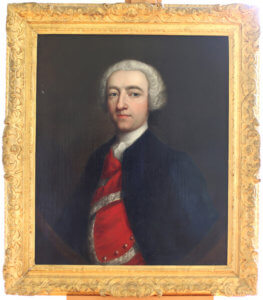
William Drake was MP for Amersham for 50 years from 1746 – 1796 but never made a speech in the House of Commons, although he did vote.
The Tyrwhitt Drake family – a succession of Sheriffs of Buckinghamshire
In 1796, following William’s death, his second son Thomas inherited the estate because his elder brother had died the previous year without male heirs. Thomas had changed his name to Tyrwhitt in 1761, when he inherited the Lincolnshire property of Sir John Delafountain Tyrwhitt, a descendent of his great great aunt Mary Drake. On his father’s death he inherited the Drake estates and changed his name again and became Thomas Drake Tyrwhitt Drake (1749-1810). He married Anne, the daughter of the Rev. William Wickham of Garsington and his co-heir with her sister Mary. They had 14 children and his brother John, the Rector of Amersham since 1775, married her sister, Mary. Thomas bought more property around Amersham, including Hyrons Farm next to Amersham Common. He was MP for Amersham from 1796 to his death in 1810, when his estate passed to his son Thomas Tyrwhitt Drake (1783-1852).
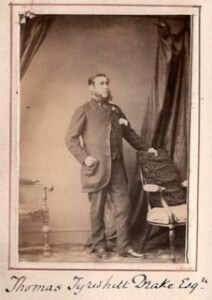 Thomas Tyrwhitt-Drake. In the 1880s it became fashionable to put a hyphen between linked surnames and so he became Thomas Tyrwhitt-Drake.
Thomas Tyrwhitt-Drake. In the 1880s it became fashionable to put a hyphen between linked surnames and so he became Thomas Tyrwhitt-Drake.
Thomas, and his brother John, whom he appointed Rector of Amersham in 1826, also married two sisters, Barbara Caroline and Mary, the daughters of Arthur Annesley of Bletchingdon, who were said to have been good horsewomen. Thomas was Master of the Bicester Hounds from 1830 to 1851, Amersham’s MP from 1805 until the reform of the rotten boroughs in 1832, and Sheriff of Buckinghamshire, although he spent most of his time hunting. He opposed the building of the London – Birmingham railway through the Misbourne Valley and the town of Amersham in the 1840s because it would have spoilt his view from Shardeloes.
Thomas and Elizabeth Tyrwhitt-Drake with their nine children on the steps at Shardeloes
Thomas was succeeded by his son Thomas (1817-1888), who was also heavily involved in foxhunting. He was Master of the Bicester Hounds on three occasions, married twice, and with his first wife Elizabeth had nine children. His second wife was Dorothy Popham.
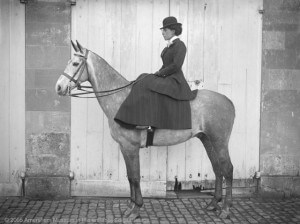
Although his father had opposed the railway, Thomas sold land on Amersham Common in 1887, which enabled the building of the Metropolitan line. In 1888, he established kennels at Shardeloes for the new pack of hounds that his cousin Captain Thomas Henry Tyrwhitt-Drake, had formed to hunt the western side of the Old Berkeley Hunt. Thomas’s son, Thomas William (1849-1900), who inherited Shardeloes in 1888, assisted as Master of this pack until 1900.

The estate passed from Thomas William to his brother, William Wykeham Tyrwhitt Drake (1851-1919), who was Master of both the Old Berkeley and Bicester Hunt prior to WW1. He sold the land at Hyrons Farm, adjacent to the new station, for house building. His eldest son Herbert “Jack”, a keen amateur jockey, died in 1915. (See an article about Jack and the Grand National in 1912)

William’s younger son Edward Thomas (1887-1933) inherited Shardeloes in 1919. He continued the family’s link with foxhunting and trained racehorses at Shardeloes.

He was Sheriff of Buckinghamshire in 1927, but was forced to sell a large part of his property in Old Amersham, including The Griffin, The Crown, The Swan and this house, at auction in 1928.
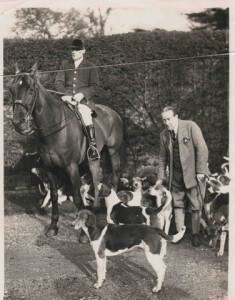
Edward had no male heir and so the estate passed to his cousin, Capt Thomas Tyrwhitt-Drake (1893-1956), who had won the Military Cross twice in WWI, but after being injured in a hunting accident in Iraq in 1924, was confined to a wheelchair. He lived at Shardeloes until 1939 and is still remembered locally as ‘The Squire’. He was succeeded by his brother Francis in 1956 and today his son William, who lives in Hampshire, is still Lord of the Manor of Amersham.
Thomas Tyrwhitt-Drake was taken to court by the Post Office for not having numbers fixed to his properties in the High Street, Amersham. He was able to open the door of one house to reveal the number fastened to the inside of the door! (See an example at 88 High Street.)
Listen to Jean Archer talking in 1991 about the Drake family curse
For more details of Shardeloes and the Drake family history, click here.
A new page has been added about the Drake memorials in St Mary’s Church.

